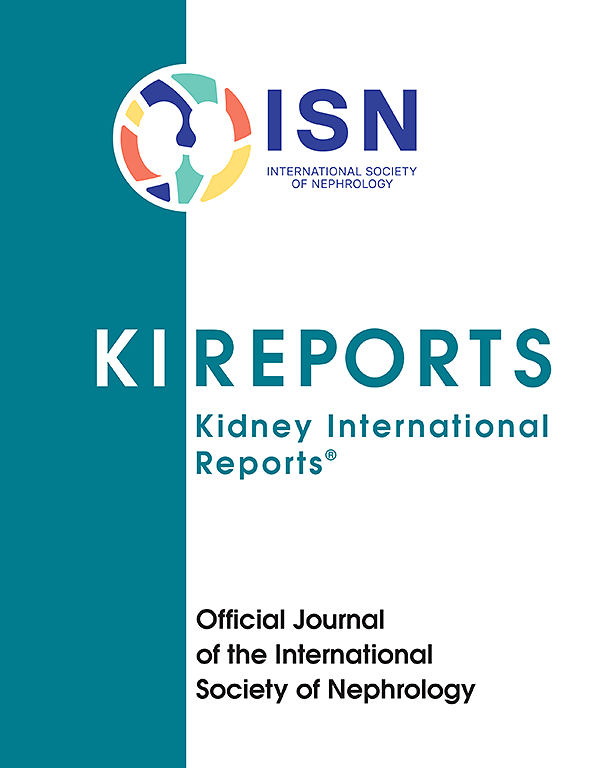Comparative Analysis of Proteinuria and Longitudinal Outcomes in Immune Complex Membranoproliferative Glomerulonephritis and C3 Glomerulopathy
IF 5.7
2区 医学
Q1 UROLOGY & NEPHROLOGY
引用次数: 0
Abstract
Introduction
C3 glomerulopathy (C3G) and primary immune complex–mediated membranoproliferative glomerulonephritis (IC-MPGN) are rare diseases that share a similar pathogenesis; however, the prognostic significance of proteinuria reduction remains poorly characterized. This study compared the outcomes in C3G and IC-MPGN and assessed the impact of changes in proteinuria on kidney prognosis.
Methods
This retrospective, longitudinal, multicenter study used joint linear mixed-effects models to assess proteinuria trajectories, and Cox regression to evaluate their association with kidney failure. In addition, time-averaged proteinuria (TA-P) was calculated to determine its impact on kidney prognosis.
Results
The study included 149 patients: 98 with C3G (66%) and 51 with IC-MPGN (34%) with a median age of 35 (interquartile range [IQR]: 22–53) years. During a median follow-up of 65 (IQR: 32–114) months, 44 patients (30%) progressed to kidney failure without differences across C3G or IC-MPGN. A strong association was observed between longitudinal increase in proteinuria and the risk of kidney failure. In addition, a ≥ 50% proteinuria reduction over time was associated with a lower risk of kidney failure (hazard ratio [HR]: 0.61; 95% confidence interval [CI]: 0.46–0.75, P < 0.001). Results were consistent in both C3G and IC-MPGN, and in those with baseline estimated glomerular filtration rate (eGFR) ≥ 30 ml/min per 1.73 m2 and proteinuria ≥ 1 g/d. A ≥30% proteinuria reduction at 6 months or a ≥50% proteinuria reduction at 12 months were associated with a slower eGFR decline. Patients were categorized into 4 subgroups based on TA-P levels, with TA-P values < 1 g/d indicating better kidney outcomes.
Conclusion
Proteinuria reduction was associated with improved kidney outcomes and slower eGFR decline in both C3G and IC-MPGN.

免疫复合物膜增殖性肾小球肾炎和C3肾小球病蛋白尿和纵向预后的比较分析
c3肾小球病(C3G)和原发性免疫复合物介导的膜增生性肾小球肾炎(IC-MPGN)是具有相似发病机制的罕见疾病;然而,蛋白尿减少的预后意义仍然不清楚。本研究比较了C3G和IC-MPGN的结果,并评估了蛋白尿变化对肾脏预后的影响。方法:本研究采用回顾性、纵向、多中心的联合线性混合效应模型来评估蛋白尿轨迹,并采用Cox回归来评估其与肾衰竭的关系。此外,计算时间平均蛋白尿(TA-P)以确定其对肾脏预后的影响。结果纳入149例患者:C3G 98例(66%),IC-MPGN 51例(34%),中位年龄35岁(四分位数间距[IQR]: 22-53)。在65个月(IQR: 32-114)个月的中位随访期间,44名患者(30%)进展为肾衰竭,C3G或IC-MPGN无差异。观察到蛋白尿纵向增加与肾衰竭风险之间有很强的相关性。此外,随着时间的推移,蛋白尿减少≥50%与肾衰竭的风险降低相关(风险比[HR]: 0.61;95%置信区间[CI]: 0.46-0.75, P <;0.001)。C3G和IC-MPGN,以及基线估计肾小球滤过率(eGFR)≥30ml /min / 1.73 m2和蛋白尿≥1g /d的患者的结果一致。6个月时蛋白尿减少≥30%或12个月时蛋白尿减少≥50%与eGFR下降较慢相关。根据TA-P水平将患者分为4个亚组,TA-P值<;1 g/d表明肾脏预后较好。结论蛋白尿减少与C3G和IC-MPGN患者肾脏预后改善和eGFR下降减慢有关。
本文章由计算机程序翻译,如有差异,请以英文原文为准。
求助全文
约1分钟内获得全文
求助全文
来源期刊

Kidney International Reports
Medicine-Nephrology
CiteScore
7.70
自引率
3.30%
发文量
1578
审稿时长
8 weeks
期刊介绍:
Kidney International Reports, an official journal of the International Society of Nephrology, is a peer-reviewed, open access journal devoted to the publication of leading research and developments related to kidney disease. With the primary aim of contributing to improved care of patients with kidney disease, the journal will publish original clinical and select translational articles and educational content related to the pathogenesis, evaluation and management of acute and chronic kidney disease, end stage renal disease (including transplantation), acid-base, fluid and electrolyte disturbances and hypertension. Of particular interest are submissions related to clinical trials, epidemiology, systematic reviews (including meta-analyses) and outcomes research. The journal will also provide a platform for wider dissemination of national and regional guidelines as well as consensus meeting reports.
 求助内容:
求助内容: 应助结果提醒方式:
应助结果提醒方式:


